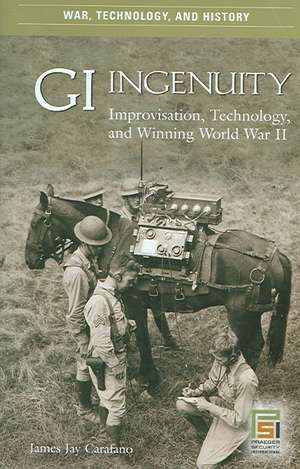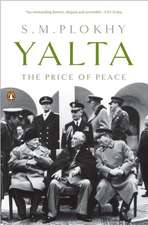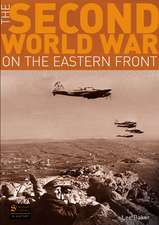GI Ingenuity: Improvisation, Technology, and Winning World War II: War, Technology, and History
Autor James Jay Carafanoen Limba Engleză Hardback – 29 iul 2006 – vârsta până la 17 ani
| Toate formatele și edițiile | Preț | Express |
|---|---|---|
| Paperback (1) | 145.64 lei 6-8 săpt. | |
| Stackpole Books – 13 dec 2007 | 145.64 lei 6-8 săpt. | |
| Hardback (1) | 289.65 lei 6-8 săpt. | |
| Bloomsbury Publishing – 29 iul 2006 | 289.65 lei 6-8 săpt. |
Preț: 289.65 lei
Preț vechi: 350.70 lei
-17% Nou
Puncte Express: 434
Preț estimativ în valută:
55.43€ • 57.99$ • 46.04£
55.43€ • 57.99$ • 46.04£
Carte tipărită la comandă
Livrare economică 03-17 aprilie
Preluare comenzi: 021 569.72.76
Specificații
ISBN-13: 9780275986988
ISBN-10: 0275986985
Pagini: 288
Dimensiuni: 156 x 235 x 27 mm
Greutate: 0.6 kg
Editura: Bloomsbury Publishing
Colecția Praeger
Seria War, Technology, and History
Locul publicării:New York, United States
ISBN-10: 0275986985
Pagini: 288
Dimensiuni: 156 x 235 x 27 mm
Greutate: 0.6 kg
Editura: Bloomsbury Publishing
Colecția Praeger
Seria War, Technology, and History
Locul publicării:New York, United States
Notă biografică
James Jay Carafano is a fellow at the Kathryn and Shelby Cullom Davis Institute for International Studies at The Heritage Foundation. He has served as an Assistant Professor of History at the U.S. Military Academy, a military historian at the U.S. Army Field Artillery School, and Director of Military Studies at the Army's Center of Military History. He has been a Fleet Professor at the U.S. Naval War College, a visiting professor at the National Defense University and Georgetown University, and a Senior Fellow at the Center for Strategic and Budgetary Assessments. Before retiring as an Army Lt. Colonel, he served as Executive Editor of Joint Force Quarterly, the Defense Department's premiere professional military journal. Dr. Carafano has written Waltzing into the Cold War: The Struggle for Occupied Austria and After D-Day: Operation Cobra and the Normandy Breakout, a Military Book Club selection.
Cuprins
Prologue: A Genius for WarWrong War, Right WarDay of the DoughboysThe Innovation RevolutionD-Day DisastersTrial and ErrorThe Air-Ground MiracleAn Imagining of ArmorThe King of BattleWarriorsEpilogue: Fantastic Voyage
Recenzii
Carafano investigates the battles that followed D-Day in Normandy through the prism of improvisation that came, in his opinion, to characterize the American GI. Nine chapters blend together military, technological, and social histories as a means to prove that the U.S. soldier had a unique genius to adjust to new combat conditions.. Carafano's knowledge shines when he recounts the battles, and enthusiasts will appreciate his asides.. Recommended. General, graduate, researcher, professional collections.
Although its subtitle ties GI Ingenuity to World War II, it presents those battlefield vignettes within a framework convincingly built on the lessons of World War I and even earlier conflicts. Specifically, several of Carafano's earliest threads extend all the way back to the 1830s and what he identifies as Prussian Gen. Carl von Clausewitz's indifference to technology.. In creating his own foundation for this excellent book, Carafano builds on Clausewitz's vision of general military genius.. The scope and creativity covered in GI Ingenuity go well beyond material solutions.. An important aspect of GI Ingenuity is the credit given to many of the Army's individual leaders, throughout the 20th century, who left their unique marks on the constructed edifice of GI ingenuity. Moreover, Carafano's individual highlights are followed by reasonable assessment of a continuing leadership legacy that is already being proven during the first decade of the 21st century.
Military historian Carafano describes how the US Army (his old outfit) transmuted from an industrial-age to a postmodern military on the battlefields of Normandy in the summer of 1944. The soldiers drew on the inspiration of their fathers' way of war, he explains, added the ingenuity of the The Greatest Generation, and presaged the military of the 21st century.
For the serious student of World War II, GI Ingenuity: Improvisation, Technology and Winning World War Two, by James Jay Carafano, is a devotee's study of American combat adaptation and creativity. GIs in Iraq continue the tradition.
Although its subtitle ties GI Ingenuity to World War II, it presents those battlefield vignettes within a framework convincingly built on the lessons of World War I and even earlier conflicts. Specifically, several of Carafano's earliest threads extend all the way back to the 1830s and what he identifies as Prussian Gen. Carl von Clausewitz's indifference to technology.. In creating his own foundation for this excellent book, Carafano builds on Clausewitz's vision of general military genius.. The scope and creativity covered in GI Ingenuity go well beyond material solutions.. An important aspect of GI Ingenuity is the credit given to many of the Army's individual leaders, throughout the 20th century, who left their unique marks on the constructed edifice of GI ingenuity. Moreover, Carafano's individual highlights are followed by reasonable assessment of a continuing leadership legacy that is already being proven during the first decade of the 21st century.
Military historian Carafano describes how the US Army (his old outfit) transmuted from an industrial-age to a postmodern military on the battlefields of Normandy in the summer of 1944. The soldiers drew on the inspiration of their fathers' way of war, he explains, added the ingenuity of the The Greatest Generation, and presaged the military of the 21st century.
For the serious student of World War II, GI Ingenuity: Improvisation, Technology and Winning World War Two, by James Jay Carafano, is a devotee's study of American combat adaptation and creativity. GIs in Iraq continue the tradition.
Descriere
Descriere de la o altă ediție sau format:
The U.S. forces that fought in Normandy during the summer of 1944 met a battle-hardened German enemy and a forbidding landscape of earthen hedgerows, sunken roads, and thick bushes and trees.
The U.S. forces that fought in Normandy during the summer of 1944 met a battle-hardened German enemy and a forbidding landscape of earthen hedgerows, sunken roads, and thick bushes and trees.













